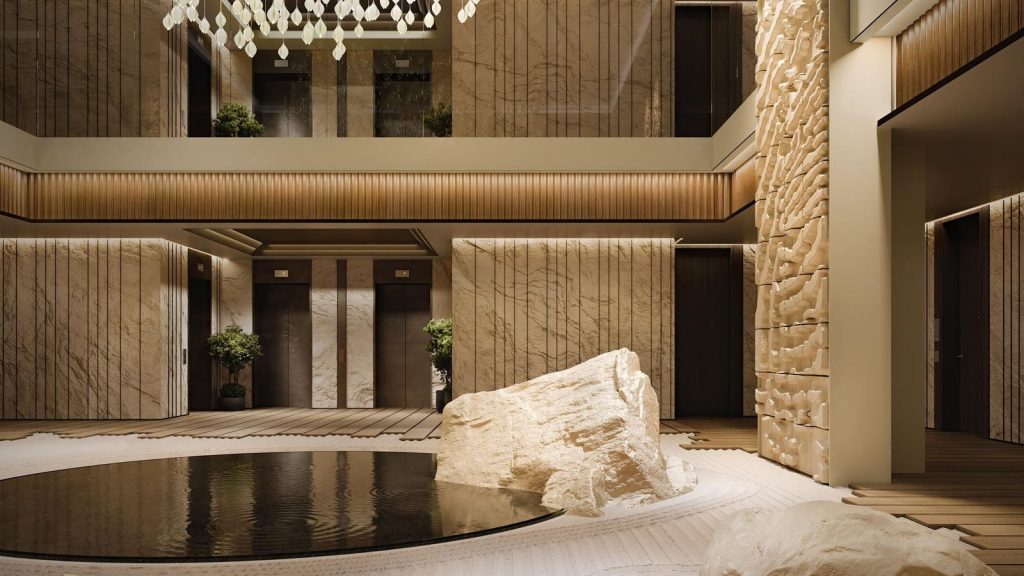Atrium floor of Aman Nai Lert Bangkok, Thailand
Photo courtesy of Denniston
Opening its doors today, Aman Nai Lert Bangkok, set within the seven-acre green oasis of Nai Lert Park, is the Aman Group’s newest urban retreat. Designed by illustrious Belgian architect and interior designer Jean-Michel Gathy, founder of the Kuala Lumpur-based firm Denniston that is renowned for its visionary approach to luxury hospitality design (including projects for Mandarin Oriental, One&Only, Cheval Blanc and Four Seasons), the 52-suite luxury hotel seamlessly blends heritage with modern elegance, drawing inspiration from the century-old Nai Lert Park Heritage Home.
Known for his signature style blending cultural heritage with contemporary sophistication, creating immersive environments that emphasize tranquility, seamless integration with nature and a strong sense of place, Gathy’s design of the new property showcases handcrafted pieces by local artisans, a collection of antiques and a striking elliptical void centered around a majestic Sompong tree. Each suite, starting at 94 sqm, features floor-to-ceiling windows framing panoramic views, while the Aman Suite, a 713-sqm presidential retreat, offers three bedrooms, a private spa and a study for an unparalleled luxury experience.
The luxury hotel is set in tranquil Nai Lert Park
Photo courtesy of Hayes Davidson
Aman Nai Lert Bangkok’s refined dining and social spaces include the 1872 lounge bar and Arva, an exceptional Italian restaurant. Aman Club Founders enjoy exclusive access to the 19th-floor open-air terrace, which houses two private restaurants, an Aman Lounge and a Cigar Bar. Wellness is central to the experience, with a two-story Aman Spa & Wellness center offering hydrotherapy, personalized treatments and a Hertitude Clinic medical facility. An infinity pool overlooking Nai Lert Park completes this urban sanctuary, solidifying Aman’s legacy of serenity, privacy and world-class service in the heart of Bangkok. Gathy discusses his philosophy behind designing the most luxurious hotels on the planet.
How has your work evolved over the past three decades?
It’s very simple. We are continuously exposed to our guests. Why? When you design a 400- or 500-room hotel, very often you don’t know your guests. They are numbers on a computer. When you design a 25-, 30- or 40-room hotel, all your guests are VIPs. You know them. I won’t mention names because of course in my business, I can’t mention names. But the who’s who of this world stay in our hotels – all of them. So we know them and because of that personal rapport that there is with most of them, they talk, they express themselves, they say what they like, what they don’t like, etc. We are continuously exposed to the clients, that niche of clients’ requests, or likes and dislikes, and therefore we are continuously refocusing our target and trying to serve their demands for the next project. So if 10 guys tell us, “A 60-sqm room is really small for me. In my home, that’s what I have for the maid,” then progressively the room becomes 80 sqm or 90 sqm. At Cheval Blanc Randheli in the Maldives, a standard room is 167 sqm. So when we designed Aman Resorts and the room was 60 sqm, people thought we were crazy. People thought Adrian Zecha was crazy. Today it’s a standard room of the Marriott! I’m talking about resort hotels, not urban hotels – that’s different.
A suite in Aman Nai Lert Bangkok
Photo courtesy of Denniston
That’s the importance of listening to your clients…
We have welcomed all of our clients’ comments continuously and we have tried to entertain their comments, complaints, advice or vision. We progressively integrate them, so we’re always up to date because we’re always here every single day. We always should have that, and of course I often meet these people. It’s a very special type of clientele. I often meet them, discuss with them, spend time with them, we fly together, etc. So finally after a while, you really think like them, you’re impregnated by their way of looking at life and looking at holidays. Therefore, you know how to interpret what they say, what they want and you keep up to date.
What is it like for a hotel designer to stay in hotels all around the world on business trips?
I’m a very strange guy. I adore hotels, I adore traveling, I travel all the time and I am extremely critical, which means I analyze everything I see. This is too small, we should have done this bigger, I don’t like the color, I think this is too aggressive, the bathrooms are too slippery, we shouldn’t use this bathroom, we shouldn’t use this shower. Whether we did it or somebody else did it is irrelevant. I have a very open mind. I have a lot of good friends who are great architects, and I have no jealousy, no pain. We are a community. Architects have a community like doctors and lawyers. We respect each other. We don’t necessarily agree with each other: I don’t agree with your style or I don’t like what you do personally, but I like you because we respect this sort of brethren between architects, just like lawyers. They sue each other, they go to court against each other, but after that, they go for dinner together. It’s quite funny. I live in luxury hotels and I go to very private villas of very wealthy people. They invite me and I see the way they live, so I’m sort of impregnated with it.

